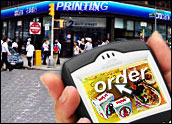
The total value of mobile payments of all types worldwide will surge from US$240 billion this year to $670 billion by 2015, Juniper Research predicts.
This covers mobile payments for digital and physical goods, money transfers and near field communications (NFC) transactions.
NFC is the mobile payment technology used in the Google E-Wallet; Apple is reportedly planning to include NFC capability in iOS 5.
The m-payment surge will be powered by the rapid adoption of mobile ticketing, NFC contactless payments, m-payments for purchases of physical goods and money transfers, according to Juniper.
“We see strong growth in NFC penetration, principally amongst smartphones over the next five years, with handset shipments featuring an NFC IC reaching 548 million in 2016,” John Devlin, senior practice director at ABI Research, told the E-Commerce Times.
Juniper Research did not respond to requests for comment by press time.
Breaking Down Juniper’s M-Research
Juniper defines mobile payments as payments for goods or services with a mobile device, but it admits that the definition of the term is open to interpretation and varies from source to source.
All segments of the mobile payment market will double or triple over the next five years, Juniper said.
About 20 countries are expected to launch NFC services in the next 18 months, resulting in transactions totaling close to $50 billion worldwide by 2014, Juniper forecast.
Digital goods will be the largest segment, accounting for nearly 40 percent of the m-payment market in 2015, according to Juniper’s calculations.
The top three regions for mobile payments — the Far East and China, Western Europe and North America — will account for 75 percent of the global m-payments’ gross transaction value by 2015, Juniper contends.
Another Take on the M-payment Market
Highlighting the problem of defining the slippery m-payments field, Juniper’s figures seem rosy when compared to predictions by ABI Research.
The global mobile transaction market will total just over half of Juniper’s projection — $371 billion by 2016 — “with a strong upside if the use of a mobile device to purchase online goods that are physical rather than digital or virtual goods and services takes off outside Asia,” ABI’S Devlin said.
M-payments in developing countries largely rely on SMS for transactions, such as remittance and mobile banking, rather than typical retail transactions, Devlin pointed out.
Japan and South Korea, which are often cited as examples of countries that have nationwide m-payment systems using smartphones, use technologies other than NFC, Devlin said.
However, that’s going to change.
Korea is migrating to NFC this year “although handsets are still in relatively short supply” and Japan is expected to follow soon, Devlin said.
The South Korean government announced in June that it plans to install or upgrade 300,000 mobile payment checkouts at major retailers and transport services this year, and that it will require mobile phone vendors to build NFC technology into all their smartphones.
M-Payments in the United States
In the United States, things are going more slowly.
Google unveiled the Google Wallet in May. It’s field-testing the technology in San Francisco and New York. Its partners include Subway, Macy’s, Citibank and American Eagle.
Starbucks unveiled an m-payment system of its own that consists of a mobile app which functions as a digital Starbucks Card. It’s available on the iPhone, iPod touch, and some BlackBerry models.
“In the U.S., it’s more a case of the first steps being taken,” ABI’s Devlin said. “Contactless cards are still being rolled out, and the POS infrastructure is still required, as are the availability of NFC-enabled handsets, of which there are only a very small number of models available currently,” he explained.
Another alternative mode of m-payment is being tested by MobilePayUSA.
The company has created apps for the iPhone, BlackBerry and Android platforms, company spokesperson Chris Woolsey told the E-Commerce Times.
It’s testing the apps in two locations — a Flippin’ Pizza and a Tutti Frutti Yogurt stores in Orange County, Calif. — Woolsey said.
“The reason m-payments haven’t taken off in the U.S. is merchants don’t want to pay another $500 to $600 per terminal to get the technology installed,” Woolsey stated.
“We’ve taken the middleman out — our technology is free to use and we make money off the marketing end of things,” Woolsey added.






















































I think that many companies have caught on to the fact that NCF purchases are a cleaver way to increase sales. In the past, charging something to your credit card was a way to buy something without "feeling it". Now, companies want to take the idea to the next level. I recently saw a company called GETONIC (www.getonic.com) that allows people with digital goods (music, wallpaper, ringtones, etc.) to sell their digital goods directly to customers and have the customers pay for them via their cellphone.
Let me explain. Loyalty cards suck because every merchant offers one, therefore I have a wallet full of them. If there were one loyalty card the problem would be solved. Let’s fast forward since physical loyalty cards will be obsolete in 2 years. The physical card will be replaced by apps, i.e. Starbucks. They have loyalty integration. What we don’t need is every business out there having a different app for payment. This is a fragmented m-payments system. I don’t want to fish through hundreds of apps to find the one specific to the store I’m in. If this were all done in a single app I could have all my loyalty in a single location. The only company I know of so far even attempting such a system is MobilePay USA. The monetary system is rapidly changing and I’m along for the ride. Goodbye Castanza wallet.